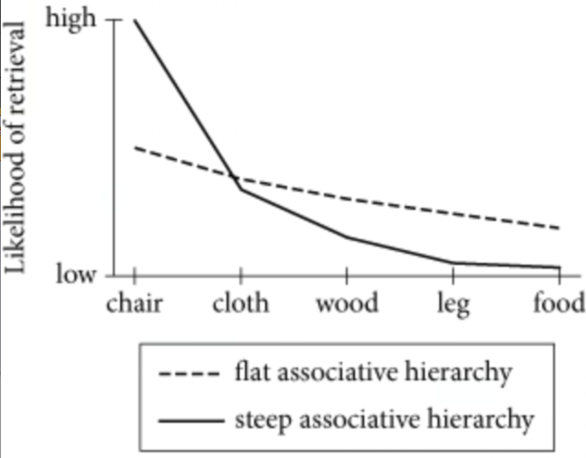



Critical Reading>Select an Answer
Fifty years ago, Sarnoff Mednick defined the processof creative thinking as "the forming of associativeelements into new combinations which either meetspecific requirements or are in some way useful. Themore mutually remote the elements of the newcombination, the more creative the process or solution." Mednick argued that creativepeople have flat associative hierarchies: they are better able to access distant, remoteassociations. For example, when given the concept "table," Mednick predicted that creativepeople would be more likely to retrieve more remote associations such as "leg" or "food." Incontrast, Mednick argued that less creative thinkers have a steep associative hierarchy, inwhich words with a higher associative strength (e.g., chair) would be more likely to enter theirminds:

The figure presents a graph of two lines. The following five words are indicated along thehorizontal axis, from left to right: chair, cloth, wood, leg, and food. The vertical axis is labeled"Likelihood of retrieval." The word low is indicated at the bottom of the vertical axis and theword high is indicated at the top of the vertical axis. One line represents a flat associativehierarchy and one line represents a steep associative hierarchy. The flat associativehierarchy line begins at the word chair, approximately midway up the vertical axis. It curvesslowly downward and to the right until it ends at the word food, approximately one-fourth ofthe way up the vertical axis. The steep associative hierarchy line begins at the word chair, atthe top of the vertical axis. It moves steeply downward and to the right until it reaches theword cloth, slightly lower than midway up the vertical axis. It then moves gradually downwardand to the right until it reaches the word leg, slightly above the horizontal axis. At this point,the line levels off until it reaches the word food. The two lines intersect at the word cloth,slightly lower than midway up the vertical axis.
[One] tool that has been used recently to look at creative cognition is Latent Semantic Analysis(LSA), an objective scoring method where you can derive a measure of semantic distance.With LSA, you can quantify the similarity between words or texts based on statisticalanalyses of the responses of a large population.
Using this technique, Ranjani Prabhakaran, Adam Green, and Jeremy Gray found that "thinslices" of verbal behavior (single-word utterances) predicted creative cognition. In their "verbgeneration" task, a noun was presented every few seconds, and the participant was instructedto say the first verb that came to mind in response to the noun. The researchers analyzed thesemantic distance of the responses using LSA.
They found that the greater the semantic distance of the noun-verb pairs, the higher the levelsof creative cognition, story-writing ability, openness to experience, and creativeachievement. Interestingly, they also found a relationship between semantic distance andtraditional measures of "convergent thinking," such as IQ and working memory. Thissuggests that creative thinking doesn't just involve combining distant associations, but alsorequires consciously accessing the associations.
According to the graph, people with flat associative hierarchies and people with steepassociative hierarchies are roughly equally likely to associate which word with theconcept "table"?
解析: